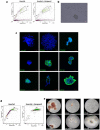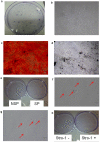Unravelling the mystery of stem/progenitor cells in human breast milk
- PMID: 21203434
- PMCID: PMC3010984
- DOI: 10.1371/journal.pone.0014421
Unravelling the mystery of stem/progenitor cells in human breast milk
Abstract
Background: Mammary stem cells have been extensively studied as a system to delineate the pathogenesis and treatment of breast cancer. However, research on mammary stem cells requires tissue biopsies which limit the quantity of samples available. We have previously identified putative mammary stem cells in human breast milk, and here, we further characterised the cellular component of human breast milk.
Methodology/principal findings: We identified markers associated with haemopoietic, mesenchymal and neuro-epithelial lineages in the cellular component of human breast milk. We found 2.6 ± 0.8% (mean ± SEM) and 0.7 ± 0.2% of the whole cell population (WCP) were found to be CD133+ and CD34+ respectively, 27.8 ± 9.1% of the WCP to be positive for Stro-1 through flow-cytometry. Expressions of neuro-ectodermal stem cell markers such as nestin and cytokeratin 5 were found through reverse-transcription polymerase chain reaction (RT-PCR), and in 4.17 ± 0.2% and 0.9 ± 0.2% of the WCP on flow-cytometry. We also established the presence of a side-population (SP) (1.8 ± 0.4% of WCP) as well as CD133+ cells (1.7 ± 0.5% of the WCP). Characterisation of the sorted SP and non-SP, CD133+ and CD133- cells carried out showed enrichment of CD326 (EPCAM) in the SP cells (50.6 ± 8.6 vs 18.1 ± 6.0, P-value = 0.02). However, culture in a wide range of in vitro conditions revealed the atypical behaviour of stem/progenitor cells in human breast milk; in that if they are present, they do not respond to established culture protocols of stem/progenitor cells.
Conclusions/significance: The identification of primitive cell types within human breast milk may provide a non-invasive source of relevant mammary cells for a wide-range of applications; even the possibility of banking one's own stem cell for every breastfeeding woman.
Conflict of interest statement
Figures






References
-
- Deome KB, Faulkin LJ, Jr, Bern HA, Blair PB. Development of mammary tumors from hyperplastic alveolar nodules transplanted into gland-free mammary fat pads of female C3H mice. Cancer Res. 1959;19:515–520. - PubMed
-
- Shackleton M, Vaillant F, Simpson KJ, Stingl J, Smyth GK, et al. Generation of a functional mammary gland from a single stem cell. Nature. 2006;439:84–88. - PubMed
Publication types
MeSH terms
LinkOut - more resources
Full Text Sources
Other Literature Sources
Medical
Research Materials
Miscellaneous

